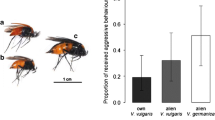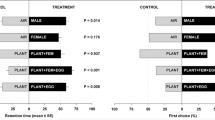Abstract
FemaleBracon mellitor Say responded to the frass of dietreared boll weevil larvae by probing with the ovipositor. Similar responses were elicited by the hexane and chloroform-methanol fractions after differential extraction of boll weevil feces. The active component of the chloroform-methanol fraction was identified as methylp-hydroxybenzoate (methyl parasept). Because the methyl parasept is an artificial component of the diet, the results suggest that the parasitoid response may be associatively learned. The response to methyl parasept decreased with time in the absence of reinforcement. Results demonstrate that certain chemicals may release behavior normally evoked by kairomones, and may interfere with the isolation of natural kairomones.
Similar content being viewed by others
References
Adams, C.H., andCross, W.H. 1967. Insecticide resistance inBracon mellitor, a parasite of the boll weevil.J. Econ. Entomol. 60:1016–1020.
Adams, C.H., Cross, W.H., andMitchell, H.C. 1969. Biology ofBracon mellitor, a parasite of the boll weevil.J. Econ. Entomol. 62:889–896.
Arthur, A.P. 1966. Associative learning inItoplectis conquisitor (Say) (Hymenoptera: Ichneumonidae).Can. Entomol. 98:213–223.
Arthur, A.P. 1971. Associative learning byNemeritis canescens (Hymenoptera: Ichneumonidae).Can. Entomol. 103:1137–1141.
Brown, W.L., Jr., Eisner, T., andWhittaker, R.H. 1970. Allomones and kairomones: Transspecific chemical messengers.Bioscience 20:21–22.
Cross, W.H. 1973. Biology, control and eradication of the boll weevil.Annu. Rev. Entomol. 18:46.
Cross, W.H., andChesnut, T.L. 1971. Arthropod parasites of the boll weevil,Anthonomus grandis: 1. An annotated list.Ann. Entomol. Soc. Amer. 64:516–527.
Cushman, R.A. 1911. Studies in the biology of the boll weevil in the Mississippi Delta region of Louisiana.J. Econ. Entomol. 4:423–448.
Folch, J., Lees, M., andSloane-Stanley, G.H. 1957. A simple method for the isolation and purification of total lipids from animal tissues.J. Biol. Chem. 226:497–509.
Folsom, J.W. 1936. Observations onMicrobracon mellitor (Say) in relation to the boll weevil.J. Econ. Entomol. 29:111–116.
Hendry, L.B., Greany, P.D., andGill, R.J. 1973. Kairomone mediated host-finding behavior in the parasitic waspOrgilus lepidus.Entomol Exp. Appl. 16:471–477.
Hunter, W.D., andHinds, W.E. 1905. The Mexican cotton boll weevil.USDA Bur. Entomol. Bull. 51. 181 pp.
Jones, R.L., Lewis, W.J., Bowman, M.C., Beroza, M.C., andBierl, B.A. 1971. Host- seeking stimulant for parasite of corn earworm: Isolation, identification and synthesis.Science 173:842, 843.
McGovern, W.L., andCross, W.H. 1974. Oviposition of a parasite,Bracon mellitor, attacking larvae of the boll weevil inside the cotton square.Ann. Entomol. Soc. Amer. 67:520, 521.
Pierce, W.D. 1908. Studies of parasites of the cotton boll weevil.USDA Bur. Entomol. Bull. 73. 63 pp.
Pierce, W.D. 1910. On some phases of parasitism displayed by insect enemies of weevils.J. Econ. Entomol. 3:451–458.
Quinn, W.C., Harris, W.A., andBenzer, S. 1974. Conditional behavior inDrosophila melanogaster.Proc. Nat. Acad. Sci. 71:708–712.
Schildknecht, H. 1968. Das Arsenal der schwimmakäfer Sexualhormone und “Antibiotica”.Nachr. Chem. Tech. 18:311.
Schildknecht, H., Holoubek, K., Weis, K.H., andDramer, H. 1964. Defensive substances of the arthropods, their isolation and identification.Angew. Chem. 3:73.
Sinoh, P. 1974. Artificial diets for insects.N.Z. Dept. Sci. Ind. Res. Bull. 214. 26 pp.
Taylor, R.J. 1974. Role of learning in insect parasitism.Ecol. Monogr. 44:89–104.
Vanderzant, E.S., andDavich, T.B. 1958. Laboratory rearing of the boll weevil. A satisfactory larval diet and oviposition studies.J. Econ. Entomol. 51:288–291.
Vinson, S.B. 1975. Biochemical coevolution between parasitoids and their hosts. Pages 14–48,in P. W. Price (ed.),Evolutionary strategies of parasitic insects and mites. Plenum, New York.
Whittaker, R.H., andFeeny, P.P. 1971. Allelochemics: Chemical interactions between species.Science 171:757–770.
Willard, J.F. 1927. Parasites of the pink bollworm in Hawaii.USDA Tech. Bull. 19. 15 pp.
Author information
Authors and Affiliations
Additional information
This paper was approved for publication as TA 12350 by the Director, Texas Agricultural Experiment Station. This study was conducted in cooperation with the USDA. It was supported, in part, by the National Science Foundation and the International Biological Program (NSF-SC-0030) of the University of California. The findings are those of the authors, and not necessarily those of the University of California or the National Science Foundation. Mention of a proprietary or commercial product in this paper does not constitute an endorsement of this product by the USDA.
Rights and permissions
About this article
Cite this article
Vinson, S.B., Henson, R.D. & Barfield, C.S. Ovipositional behavior ofbracon mellitor say (Hymenoptera: Braconidae), a parasitoid of boll weevil (anthonomus grandis Boh.). J Chem Ecol 2, 431–440 (1976). https://doi.org/10.1007/BF00988808
Received:
Revised:
Issue Date:
DOI: https://doi.org/10.1007/BF00988808




